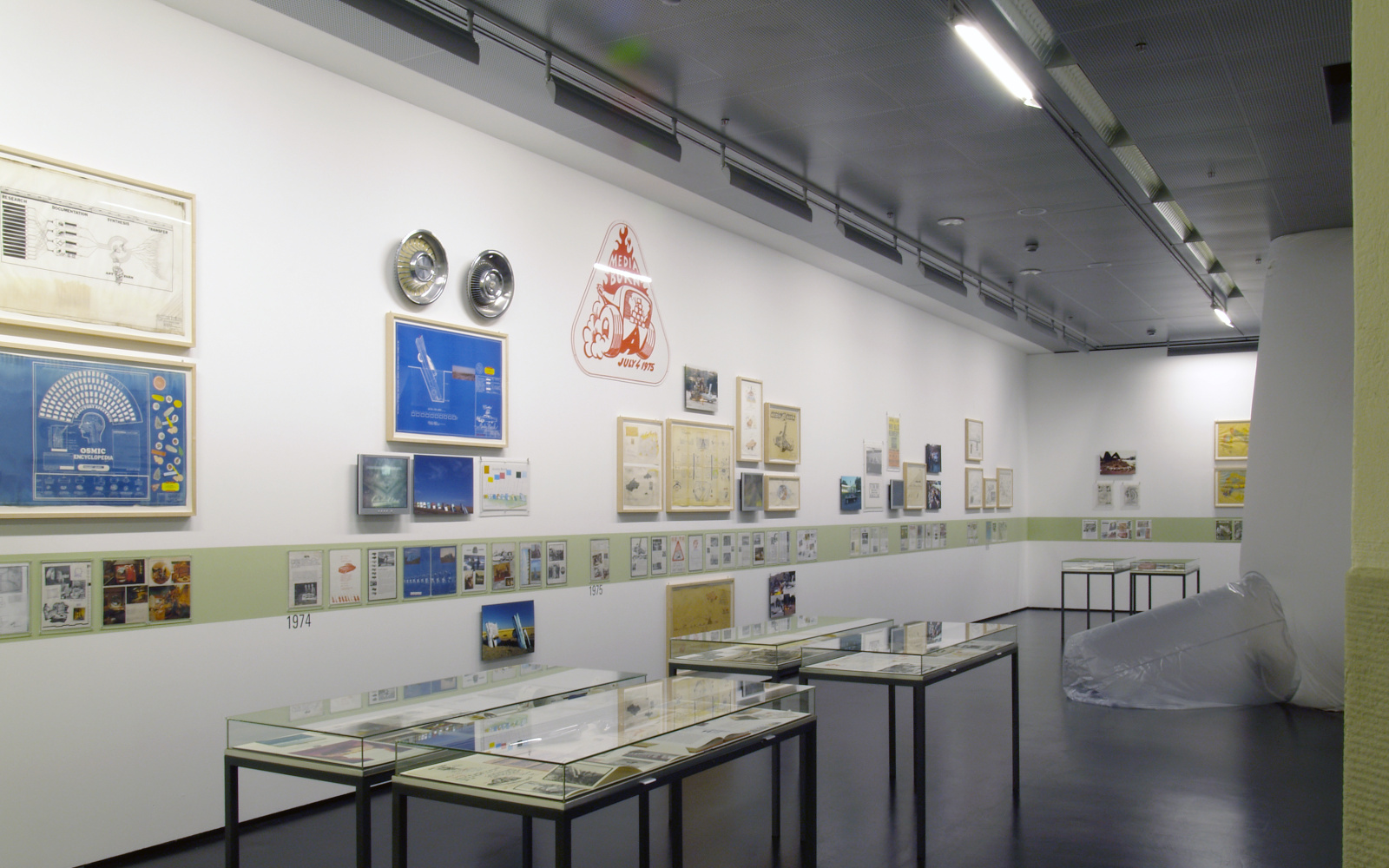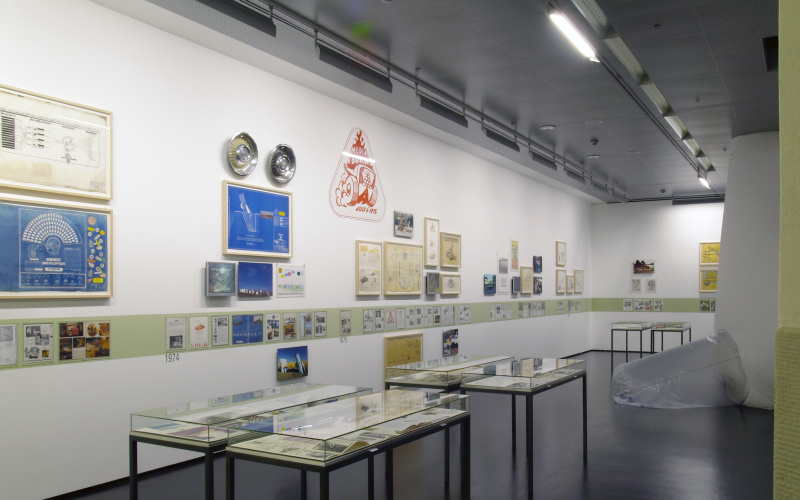- Programmpunkt
- Vortrag
Chip Lord: Some Notes on Ant Farm
Art, Architecture, Performance and Video
Sa, 30.04.2005
- Ort
- Vortragssaal
1968
(October) Ant Farm was founded by Chip Lord and Doug Michels in San Francisco.
1969
Lord and Michels, teaching at the University of Houston College of Architecture, joined by Doug Hurr, staged a series of free-form 'architectural performances' on the beach at Freeport, Texas. Using several 60-foot diameter cargo parachutes as temporary kinetic structures, Time Slice events revolved around a nomadic lifestyle and experimental multimedia image making.
(June) Lord, Michels, and Tom Morey, Pepper Mouser, and 'Lucky' Jackson dressed in business suits and handed out cash while 'occupying' a vending machine room at a large Houston corporate complex. The piece, Plastic Businessman, resulted in the arrest of the five for trespassing. A Super-8mm film is the only documentation of this performance.
(September) Space Cowboy: An installation/performance at a fundraising event at Houston's Alley Theatre included an inflatable, live video, projected slides, an American flag cake, and six Ant Farm 'technician/performers' dressed in white jumpsuits with head-mounted lights. (First use of video.)
Invited to the 6th Paris Biennial, Ant Farm sent a time capsule, the Electronic Oasis sculpture - a cardboard box mounted on a plywood platform, containing souvenirs of the 1969 moon landing, and Texas cowboy artifacts. On the steps of the Musée d'Art Moderne de la Ville de Paris, Doug Michels and a traveling companion performed a live love act under a large American flag, performance titled »Make Love Not War«.
(September) Michels set off for India, Lord returned to California and Ant Farm re-formed in Sausalito with the addition of Hudson Marquez, Joe Hall, Andy Shapiro, Kelly Gloger, Curtis Schreier, and Michael Wright. Emphasis was on inflatable sculptures and events using them. One such event was videotaped by David Cort, Parry Teasdale and others in the CBS-funded precursor to Videofreex.
1970
Invited to Experiments in Art & Technology's show at the University of Southern California (USC) campus, Ant Farm (Lord, Hudson Marquez, Curtis Schreier, and Joe Hall) inflated a giant 'spare tire' and projected gas station slides while the room (a classroom) filled with the smoke of two highway flares. A cake decorated like a tire was served to the remaining audience as the event ended. (The artists were dressed in service station uniforms and wore gas masks for Gas Station.)
Ant Farm acquired a Sony porta-pak (with no editing system). Early tapes are scrapbook/improv experiments. Video served as a process tool for the group's creative interaction. Doug »Swami« Michels returned from India in May. Truckstop Network incorporated video. Through Radical Software contact was made with: Media Access Center, Palo Alto (Allen Rucker, Shelly Surpin, et al); Raindance (Michael Shamberg, Beryl Korot, Ira Schneider); and Videofreex. Doug Hurr built an experimental sailboat in Ant Farm Gate 5 warehouse.
Ant Farm was retained by Holt, Rinehart, & Winston to design Guerilla Television. Tapes made during this period were later made into »Ant Farm's Dirty Dishes«, 14 minutes (not in distribution).
Ant Farm architects, Michels (with Morey), design architecture for new Visual Arts Building at Antioch College in Yellow Springs, Ohio. The bright yellow metal warehouse structure with slanting mirror-glass roof contrasts vividly with quaint vine-covered small town college campus (construction completed in 1971).
1971
Video Slumber Party, March 6, 1971, at the Sausalito Arts Center. An all-night environment of inflatables and live and taped video that brought together groups in the San Francisco area working in video. Inflatocookbook written and produced.
Newman Media Studio, design and construction of studio and screening room for San Francisco art collector Jim Newman featured first convergence of architecture and media technology (telematics) in Ant Farm's architectural work.
(Spring) Truckstop project included performance/installations using the Ice 9inflatable and video at several colleges. Most notable was the performance at Yale's School of Art and Architecture in which the lounge singer (met working at a local car wash) Johnny Ramao, sings »I need your love« in front of an audience of disgruntled Yale faculty members and students.
(November) Michels & Lord joined by partner Richard Jost, traveled to Houston to design and build The House of the Century, an experimental ferro-cement residence for Mr. and Mrs. Lubetkin. Doug Hurr joined the design team to build interior elements. Marquez and Schreier remained in San Francisco. Other members disbursed.
Video was used as communication between San Francisco and Texas; also, early »fax« with Xerox telecopies to transmit design ideas.
1972
Discussions between Michael Shamberg, Rucker, Marquez, Michels, and Lord lead to the conceptualization of Top Value Television (TVTV).
On the road to Houston, the media van crew stopped at a groundbreaking ceremony in Scottsdale, Arizona. Doug Michels, wearing a woman's mask (Halloween type) and cowboy hat interviewed various serious officials in the videotape Passing the Buck.
(March) The Contemporary Arts Museum, Houston, commissioned Ant Farm to create a Houtx Time Capsule work for the opening of the Museum's new building. Integral to this work was a video component, six hours of taping around the opening festivities, interviews with the artists, etc. The Houtx Time Capsule refrigerator was slated to be opened in March 1984. However, the capsule itself was damaged in a flash flood at the museum in 1977. Ant Farm's Houtx Time Capsule, was stored at The Art Guys studio for many years and was finally opened by Lord, Schreier, and Michels in September 2000.
(July) Democratic Convention, Miami, Florida. Marquez, Lord, Michels and Schreier all participated in TVTV's first project.
(August) Republican Convention. Lord and Marquez represented Ant Farm at TVTV's second endeavor. Lord, Shamberg, and Williams edited Four More Yearsat The Egg Store in New York (with Chuck Kennedy and Jody Sibert). Michels and Jost remain in Texas to complete construction on House of the Century.
1973
Michels and Lord returned to San Francisco and Ant Farm studio was established at Pier 40. Marquez split his time between TVTV and Ant Farm before leaving Ant Farm in 1974 to work full time with TVTV in Los Angeles. Lord, Michels, and Schreier were core Ant Farm members from here on.
Horns and Headlights was performed at the University of Michigan and utilized 25 cars that performed to a score conducted by Michels and Schreier.
(December) Marquez and Doug Hurr contributed an Anthology tape, 4*2*Maro, an information show at the Contemporary Arts Museum, Houston.
Convention City. Inspired by the TVTV convention coverage experience, Michels, Lord, and Schreier designed a permanent location for American political conventions, a supercity in Texas that is more a giant television studio than traditional convention hall. In Ant Farm's vision, »Election Day« takes on new meaning as American political conventions become a Nationwide Presidential video game played by entire country. The Convention City project premiered at a live press conference at Rice University.
1974
(June) Cadillac Ranch, a monument to the rise and fall of the Cadillac tail-fin on US Route 66, was proposed and built for Stanley Marsh III of Amarillo, Texas, by Lord, Marquez, and Michels. Marsh's TV station, KVII-TV aided in the production of The Cadillac Ranch Show videotape which includes performances by Lord, Michels, Marquez, and Roger Dainton, as well as Stanley Marsh III.
2020Vision Ant Farm's exhibition at the Contemporary Arts Museum in Houston featured visionary art and architecture projects as well as LIVE video link to NASA's orbiting SkyLab space station beamed into a simulated Living Room of the Future.
Freedomland, a teen-age shopping mall commissioned by the Century Development Company of Houston. Designed by Michels, Schreier, and Jost, the Freedomland project featured first use of video (directed by Skip Bloomberg) to present an Ant Farm architectural project to a client.
1975
(July) Media Burn (performance, sculpture, video production) created and produced by Lord, Michels, Schreier, and Uncle Buddie with the support of Tom Weinberg and Howard Wise, was performed on the 4th of July at the Cow Palace in San Francisco. More than 400 spectators attended the patriotic Independence Day event.
(August) The Eternal Frame produced on location in Dallas, Texas, by Ant Farm (Lord, Schreier, Michels) and T.R. Uthco (Doug Hall, Diane Lane Hall, and Jody Procter), with help from Jim Newman, Stanley Marsh III, and The National Lampoon. This performance for video done on location in Dallas is a faithful re-enactment of the Kennedy assassination. Doug Hall played the Artist-President, Doug Michels is Jackie Kennedy, the Artist-First Lady. The video (edited by Lord, Michels, and Hall), 22 minutes long, in color and black and white premiered on November 22, 1975 in San Francisco and later installed at the Long Beach Museum of Art on Nov. 22, 1976.
(September) Citizen's Time Capsule by Lord, Michels, and Schreier, contained articles and images for the year 2000 was buried in a 1968 Oldsmobile Vista Crusier station wagon at Artpark in Lewiston, New York. 1975 off-air news coverage and a videotape produced by Artpark staff exists of this event. Citizen's Time Capsule has yet to be opened.
1976
During an Australian tour, Michels, Schreier, and Hurr created and produced a live performance of CARmen, an opera for 35 autos at the Sydney Opera House (videotape documentary edited by Michels).
Ned Telly and the Golden Spanner, a modern performance-version of the famous Australian outlaw Ned Kelly created by Hurr, Michels, and Schreier. Golden spanner is used to symbolically unbolt Sydney's Harbour Bridge. (Off-air video exists)
Future Cake, an Ant Farm bicentennial performance on July 4, 1976 in the Australian capital city of Canberra features Ned Telly (TV head man) standing in aquarium of simulated blood in front of a massive ant-covered American birthday cake. (videotape lost)
Dolphin Embassy, an interspecies communication experiment initiated in Australia by Michels and Schreier, was an innovative project that featured the first use of video technology as a tool to communicate with dolphins. Dolphin Embassy (Australia research project) was submitted to Howard Kline, Director of the Rockefeller Foundation and accepted for grant funding. Dolphin Embassyincorporated as a 501-C3 non-profit foundation.
Automerica was published by E.P. Dutton and Company (written by Lord, designed by Lord and Schreier).
Ennui, a movie theater architecture project (designed by Lord, Michels, Schreier) for the enigmatic San Francisco musical group The Residents, featured innovative use of projected image and sound technology as well as California's first unisex bathroom.
1977
(January) Dolphin Embassy exhibit premiers at the San Francisco Museum of Art. Ambassador Michels returns to Sydney, Australia (with Hurr) to realize Dolphin Embassy vision, design the Oceania sea craft, and communicate with wild dolphins. Joined by Australians Alexandra Morphett and Bob Perry, Dolphin Embassy ideas were introduced to Australia via broadcast television, mass-media and creative events.
Tele-Vision, Ant Farm's Ned Telly (TV Head character), morphs into superhero and runs for Lord Mayor of Sydney. The Michels conceived and directed avant-garde media campaign »Tele-Vision reflects your view« tests outer boundaries of art and politics. Tele-Vision candidate comes in third in a field of seven. (»Vote Vision« video lost.)
Philip Garner and Chip Lord performed Chevrolet Training Film: The Remake at La Mamelle, San Francisco and Some Serious Business, Los Angeles. The live performance incorporates film segments from the original sales training film. Technically, not an Ant Farm project, but partially funded by a National Endowment for the Arts grant to the Ant Farm Project.
1978
On August 7th, fire destroys the Ant Farm studio at Pier 40, San Francisco. 90% of the slide and video documentation was saved, very little else survived, and Ant Farm disbands.
Impressum
- Kurator/in

